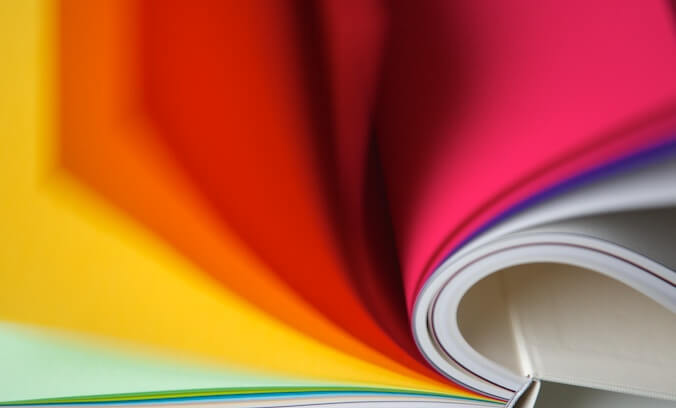
Paper finishes demystified
Friday 27 November 2015
I interviewed Matthew Fearon from Lemon Press about the differences between the main paper finish options.

Friday 27 November 2015
I interviewed Matthew Fearon from Lemon Press about the differences between the main paper finish options.
If you are commissioning printed materials then at some point in the process either your designer or your printer will begin talking about choosing paper. The paper that you select can massively affect the overall quality, look, and feel of your printed materials, so it’s important to make the right choice.
But paper comes in a dizzying variety of sorts, and with it comes a whole new range of terminology. Understanding that terminology will help you to narrow down the options and find the best paper for your project.
I asked Matthew Fearon from Lemon Press to help explain the differences between the main paper finish options.
This kind of paper, as the title suggests, has a type of coating on it that is usually made of china clay. Coated paper can have a finish that is either glossy, silky or matt and is ideal for projects that require a fine finish. For this reason coated paper is also referred to as ‘art paper’ – the finest example of coated paper stock.
Coated paper is most often used to print leaflets, menus, pamphlets, and brochures.
Uncoated paper does not have a china clay coating or glossy finish. It is not as smooth as coated papers, having a slightly grainy texture to it. This is the most common form of paper found in your local stationery supplier and is ideal for use in laser printers and photocopiers.
This type of paper is also the preferred choice for business stationery and is widely used for this purpose. It is becoming more and more popular for the printing of prestigious brochures and catalogues – especially for companies who want to give a more natural feel to their image but without the expense of recycled material. For this reason it’s the best alternative to coated art paper.
Laid is another type of finish that emulates the look of fine hand-crafted paper from the early days. Its texture is made up of horizontal and vertical ribs known as ‘chain lines’. These are created using a dandy roll (wire cylinder) which impresses the pattern into the paper along with the watermark at the wet end of the manufacturing process.
This is premium quality paper that is often used for business stationery and gives it an air of prestige and luxury.
This is also premium quality paper like the laid paper, but without the textured or ribbed patterns. This paper is also widely used for business stationery.
Linen paper looks and feels like the fine linen fabric for which it is named. It has a subtle embossed texture with a crosshatch pattern that is reminiscent of a fine linen table cloth. Paper with a linen finish is often used for personal stationery, business letterheads or fine restaurant menus.
This is the most common type of uncoated paper and is readily found in many offices, big and small. It is known as the economical paper or uncoated wove paper. This is the paper type commonly used in fax machines or photocopiers.
Recent posts
Featured posts

Hello! I’m Sarah, an independent typographic designer, helping businesses to communicate their unique selling points through printed marketing and communications.
I’ve been sharing my knowledge about design, typography, marketing, branding and printing since 2014. I hope you enjoy reading my blog.

Sarah Cowan